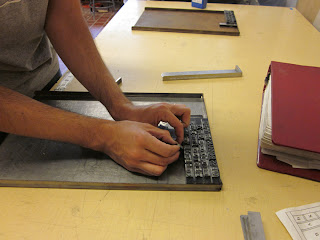The workshop was conceived of as being for absolute beginners, so we needed to cover all of the basics: history and context, hand typesetting, and how to set up and print on the presses. And of course we wanted it to be as hands-on as possible, with the students being engaged in the making of a finished piece.
This broadside, from a similar workshop done at the beginning of the Press’s existence, was hanging in the display case outside of our front door:
and it became the model for what we did. The students were divided into teams of two. Each group wrote a pangram: a text containing every letter of the alphabet. One of the most well known pangrams, often used for type specimens, is: “The quick, brown fox jumped over the lazy dog.” Then each group chose a typeface, and set the name of the face in caps, all of the lowercase letters in order, and then their pangram. One group added the figures in order to make their spacing/arrangement better.
After all of the type was set and proofed, each group worked on designs for the broadside, potentially incorporating images from blocks we had around the studio, and/or a title in wood type. After each group had a design we all looked at them together and came to a consensus. Then we chose paper and ink colors.
Day 2 was production day, where we set up the presses and ran both colors. Our 219 and Universal III are the same size, so we used those, which also gave everyone the opportunity to print on both an automatic and a hand-cranked press.
Setting up and printing went really smoothly, and we ended up with a really great looking type specimen broadside:
And at the end everyone signed every copy.
Teaching workshops is so much fun—there’s no academic pressure, no grading or evaluation, and every student is there because they are genuinely interested. This particular workshop was so much fun and so successful—we will definitely be doing more in the future, so stay tuned!














No comments:
Post a Comment